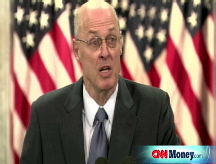Lending expands in nervous market
Central bank is buying corporate debt, but other investors have been resistant to lend in a still jumpy market.
NEW YORK (CNNMoney.com) -- A key market for lending to major businesses and banks expanded for the second week in a row but, aside from the Federal Reserve, few others are jumping on the lending bandwagon.
According to a Fed report on Thursday, the amount of so-called commercial paper that was sold in the seven days ended Nov. 5 rose by $50.5 billion, or 3.3%, to a seasonally adjusted $1.6 trillion - a five-week high.
Still, lending lags behind levels from a year ago when $1.9 trillion changed hands. Business lending had been steadily declining since mid-September. In that span, outstanding commercial paper had fallen 20.2% - the greatest drop on record - to its lowest point since April 2005.
The Fed's unprecedented actions to buy up hundreds of billions of dollars of high-quality, three-month commercial paper through its Commercial Paper Funding Facility appear to have boosted the market, but early indications show the central bank's program has not yet encouraged free market investors to buy up corporate debt.
"Investors are not interested in the commercial paper market anymore, because they don't want unsecured loans," said Bill Larkin, portfolio manager Cabot Money Management. "The market for it will come back, but it will take a long time to do so."
Commercial paper is short-term debt that big businesses and financial institutions sell primarily to money-market fund managers and other institutional investors. The companies use the loans to fund day-to-day business operations. The market for it, particularly for three-month paper, dried up after the collapse of Lehman Brothers in mid-September.
"Yields on money-market funds have fallen, which is an indication that they're holding onto even safer investments than commercial paper," said Larkin. "It's a shifting of risk - in this kind of market, investors care only about getting a return, period."
The Fed had hoped that is program would serve as a backstop for the market, encouraging other lenders to buy up paper as well. The program still may take hold, but the wait may be longer than the Fed had hoped for.
Over the past week, there was huge drop-off in issuance of paper with maturities of more than 80 days - the paper that the Fed agreed to purchase. The volume stood at just $15.9 billion, significantly lower than last week's daily average of $52.7 billion.
In the past week, only 10.2% of all commercial paper on the market matured in more than 80 days, compared to 26.5% in the previous week. That's still up from the 4% seen in the week prior to the opening of the Fed facility. Before Lehman Brothers' collapse, three-month paper made up more than 11% of the market.
The central bank had placed limits on how much paper each company could sell to the Fed. As those limits were reached, the market for three-month paper contracted.
As of last Thursday, the Fed had bought $143.9 billion in commercial paper through its program. The past week's purchases will not be known until 4:30 p.m. ET, when the central bank releases its weekly balance sheet data.
The encouraging news about the Fed's facility is the lowering of borrowing rates. Many analysts have credited the Fed's offer of low 3-month commercial paper rates with nudging other rates lower.
Accordingly, most commercial paper rates fell this week compared to last week. The lower rates are also helping bring down the 3-month Libor rate - which fell to its lowest level in nearly four years on Thursday. That's a major boost for the strangled credit markets, as more than $350 trillion is assets are tied to Libor.
Lower interest rates make it easier for companies to lend to one another. The Fed hopes its actions encourage lending and help bring the credit crisis to an end.
But one possible reason why the Fed's program has not yet encouraged other lenders is that the Fed offers much lower borrowing rates than the rest of the market. The Fed offered rates as low as 1.54% for three-month paper Wednesday, but the free market's rates for similar paper stood at about 2.5%.
"Until the free market rate gets in line with the Fed's rates, people will continue to issue paper to the Fed and no one else," said Andrew Brenner, senior vice president of MF Global. "The Fed's borrowing rates are just so low."
The Fed's new program has given companies access to critical longer-term financing. The lack of longer-term lending in the previous six weeks had worried companies looking for financing for the last few months of the year.
The fourth quarter is the most critical period for lending, as financial institutions are hesitant to lend with the risk of taking a hit to their balance sheets at the end of the year. But if the Fed program is unable to attract other investors, those concerns may reappear.
Several dozen companies registered for the Fed's program, including General Electric Co. (GE, Fortune 500), which is the largest issuer of commercial paper. Other companies subscribing to the program include Morgan Stanley (MS, Fortune 500), car and home lender GMAC (GMA), American Express (AXP, Fortune 500), and bailed-out insurance firm AIG (AIG, Fortune 500).
Did you vote for Obama? How do you think the new president will affect your wallet? What do you think Obama needs to do to fix the economy - both in the short run and the long term? What should be first on the new Congress's agenda? E-mail us your thoughts, including your name, photo and contact info; the best answers will be featured in an upcoming CNNMoney.com article. ![]()


